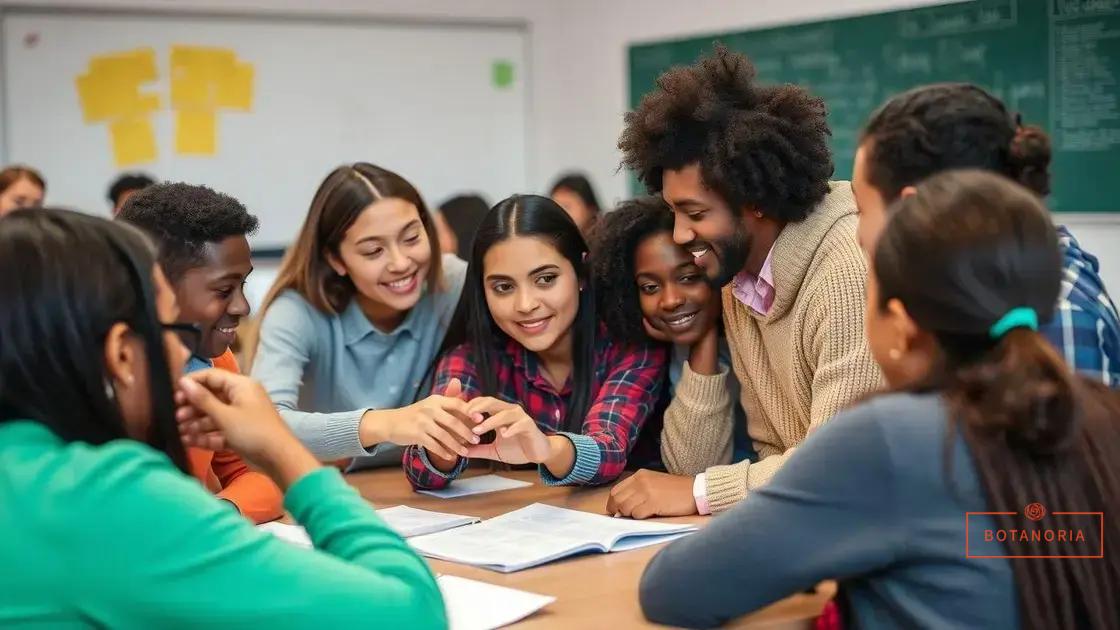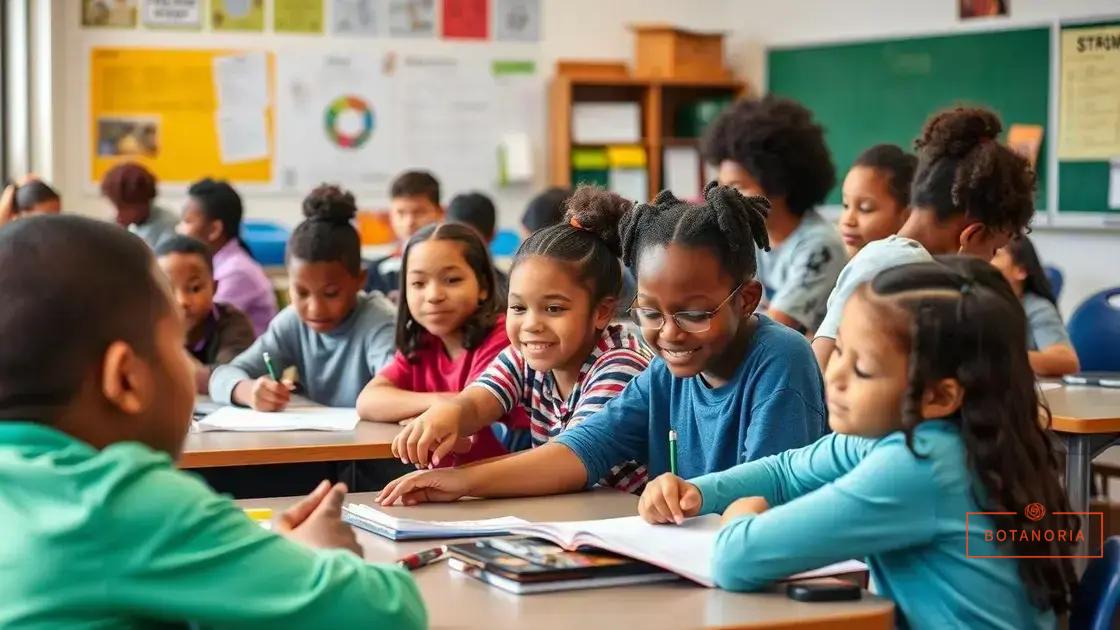Inclusive educational practices: unlocking potential in every learner

Inclusive educational practices ensure that all learners, regardless of ability, feel valued and supported, promoting collaboration and enhancing academic outcomes in diverse classroom environments.
Inclusive educational practices play a vital role in creating equitable learning environments. By embracing diversity, teachers can unlock the potential of every student. How can we make our classrooms more inclusive and engaging?
Understanding inclusive educational practices
Understanding inclusive educational practices is essential for creating a supportive learning environment. These practices aim to accommodate all students, regardless of their backgrounds or abilities. By focusing on inclusivity, educators can ensure that every student has the opportunity to thrive.
Key Principles of Inclusive Education
One of the primary goals is to create accessible learning experiences. This means adjusting teaching methods to fit diverse learning styles. For instance, some students benefit from visual aids, while others may prefer hands-on activities.
Another important aspect is fostering a sense of community in the classroom. When students feel valued and included, they are more likely to engage in their education.
- Adapt teaching strategies to meet varied learning needs.
- Encourage collaboration among all students.
- Implement flexible assessment methods.
Additionally, it’s crucial to provide the necessary resources. Schools should ensure that all students have access to materials that will help them succeed. This might include assistive technology or additional support staff.
Respecting cultural diversity also plays a vital role in inclusive practices. Educators should integrate multicultural perspectives into the curriculum. This not only enriches learning but also helps students appreciate and understand each other’s backgrounds.
Benefits of an Inclusive Approach
There are numerous benefits to adopting an inclusive approach. First, it cultivates empathy among students. When individuals learn together, they grow to appreciate differences and develop social skills. Moreover, inclusive classrooms often lead to improved academic outcomes for all. Students who might struggle in a traditional setting can flourish when given the proper resources and support.
By implementing inclusive educational practices, we create an environment where every student can thrive, feel validated, and reach their full potential. These practices do not just benefit students with disabilities; they enhance the learning experience for everyone.
Benefits of inclusivity in the classroom

Understanding the benefits of inclusivity in the classroom is essential for educators looking to enhance learning for all students. An inclusive classroom welcomes diverse learners and embraces their unique perspectives. This not only enriches the educational experience but also fosters a strong sense of community.
Enhanced Social Skills
When students from various backgrounds and abilities learn together, they develop essential social skills. They learn to communicate effectively, appreciate different viewpoints, and collaborate with peers. These interactions create not just better classmates but also well-rounded individuals.
- Improved empathy among students.
- Stronger teamwork and collaboration skills.
- Increased cultural awareness and sensitivity.
Additionally, inclusive classrooms can lead to better academic outcomes. Research shows that when students with and without disabilities learn together, everyone benefits. Teachers adopt varied instructional methods to meet diverse needs, helping all students thrive.
Fostering a Sense of Belonging
Another key benefit is the creation of a sense of belonging. When students see themselves reflected in the curriculum, they feel valued and included. This boosts their confidence and motivation to participate actively in lessons.
Moreover, a positive classroom environment encourages all students to engage with the material. They are less likely to become disengaged or frustrated when learning is tailored to their individual needs. This approach promotes perseverance and resilience.
Finally, inclusivity prepares students for the real world. In a diverse society, understanding and embracing differences is crucial. By experiencing an inclusive classroom, students learn to navigate a variety of social situations, equipping them with skills they’ll use throughout their lives.
Strategies to implement inclusive practices
Implementing inclusive practices in the classroom is vital for ensuring that all students feel valued and able to learn effectively. This can be achieved through various strategies that cater to a range of needs and learning styles.
Tailoring Instructional Methods
One effective strategy is to tailor instructional methods to meet the diverse needs of students. Teachers should use a mix of teaching styles to engage all learners. For instance, combining visual aids with hands-on activities can help students who learn better through different modalities.
- Use manipulatives and models for hands-on learning.
- Incorporate technology for interactive lessons.
- Provide written instructions alongside verbal ones.
Additionally, grouping students strategically can enhance collaboration and support among peers. Grouping students by mixed abilities allows for peer learning, where stronger students can help others, fostering a sense of community.
Creating an Accessible Learning Environment
Another key strategy is to create an environment that is physically and emotionally safe for all students. This includes ensuring that the classroom is accessible to those with physical disabilities. It also involves cultivating an atmosphere where students feel emotionally secure to share their thoughts without fear of judgment.
Visual aids, like charts and images, can be used to support textual information, making the learning experience richer. Encouragement and positive reinforcement can also help create a welcoming atmosphere. When students feel encouraged, they are more likely to participate actively in their learning.
Lastly, ongoing professional development for teachers is crucial. Training focused on inclusive education can provide educators with the necessary tools and techniques to support all learners effectively. They should be aware of the differences in learning styles and how to address them appropriately.
Overall, by implementing these strategies, educators can create a more inclusive classroom that promotes learning for every student, ensuring everyone has the support they need to succeed.
Overcoming challenges in inclusive education

Overcoming challenges in inclusive education is essential to create a supportive environment for all learners. Various obstacles can arise, but understanding them is the first step toward finding solutions.
Identifying Common Barriers
One challenge is the lack of resources. Schools may not have enough materials or support staff to assist all students effectively. This can hinder the implementation of inclusive practices. Teachers often feel overwhelmed when trying to meet the diverse needs of their students without adequate training or resources.
- Limited access to specialized training for educators.
- Insufficient classroom resources and materials.
- Overcrowded classrooms that make individual attention difficult.
Another significant barrier is societal attitudes. Some people still hold misconceptions about students with disabilities and their capabilities. These attitudes can affect how students with disabilities are treated by their peers, impacting their confidence and social integration.
Implementing Solutions
Addressing these challenges requires collaborative strategies. First, schools can advocate for policies that secure more funding for special education programs. By allocating resources effectively, they can better support students and provide the necessary tools for learning.
Moreover, fostering a culture of inclusivity is vital. This means educating both students and staff about the importance of diversity and acceptance. Implementing training programs that promote empathy and understanding can significantly change attitudes within the school community.
Engaging families in the education process is also crucial. When parents are involved, they can help bridge gaps between home and school, creating a more cohesive support system for students. Inclusive education thrives when everyone works together, including teachers, parents, and community members.
Ultimately, while overcoming challenges in inclusive education is no small feat, the efforts can lead to a thriving learning environment where all students can succeed.
Success stories in inclusive education
Success stories in inclusive education provide inspiring examples of how diverse classrooms can thrive. These stories demonstrate that with the right support, every student can overcome challenges and succeed.
Real-Life Examples of Inclusion
One notable example is a classroom where students with various abilities worked together on a project. A student with a learning disability excelled in providing creative ideas while their peers helped with the research aspect. This collaboration not only boosted the student’s confidence but also helped everyone learn from each other.
- Students learned to appreciate different strengths.
- Everyone contributed uniquely, enhancing group dynamics.
- Relationships built through collaboration fostered respect.
Another success story comes from a school that implemented a buddy system. In this system, students with disabilities were paired with peers who guided them during class activities. This practice not only supported the students with disabilities but also educated their peers about diversity and inclusion.
Positive Outcomes
These success stories reflect the powerful impact of inclusive practices. Research shows that when students learn in inclusive settings, they often demonstrate improved academic performance. Increased motivation and engagement can be seen across the board.
Additionally, teachers reported a more positive classroom environment. When every student feels included, it creates a sense of belonging. This atmosphere encourages open communication and collaborative learning among all students.
Finally, parents also notice positive changes in their children. Families express satisfaction when schools embrace inclusive education. They see their children thrive socially and emotionally, knowing they are accepted for who they are.
Inclusive education is not just about placing students with disabilities in a regular classroom; it’s about ensuring that every learner feels valued and supported. By understanding the benefits, implementing effective strategies, and overcoming challenges, schools can create environments where all students thrive. The success stories highlight the positive impacts of inclusivity on both academic and social outcomes. When we work together, we can foster a learning atmosphere that embraces diversity and helps every student achieve their full potential.
FAQ – Frequently Asked Questions about Inclusive Education
What is inclusive education?
Inclusive education is an approach that seeks to address the diverse needs of all learners by integrating students with different abilities into regular classrooms.
How can inclusivity benefit all students?
Inclusivity promotes empathy, cooperation, and respect among students, which enhances the overall learning experience and encourages personal growth.
What strategies can teachers use to implement inclusive practices?
Teachers can use various strategies like differentiated instruction, collaborative learning, and creating an accessible environment to support all students.
What challenges do schools face in implementing inclusive education?
Some common challenges include lack of resources, insufficient training for teachers, and societal attitudes towards disabilities that can hinder implementation.






